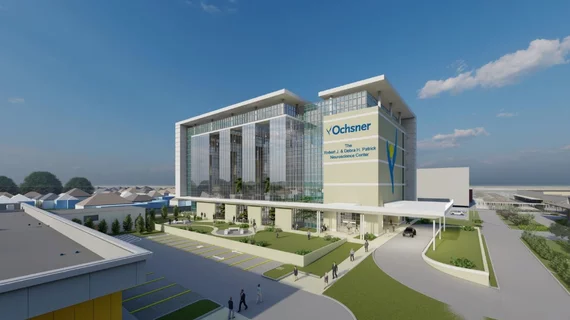Korak Sarkar, MD, vividly recalls a clinical case that clearly demonstrated the significant impact that enterprise imaging can have on healthcare delivery.
The patient arrived at the Ochsner Neuroscience Institute with a complex underlying condition of the spine that had progressed to the point where the individual could no longer walk and relied on a wheelchair to move. The clinical care team reached out to Ochsner’s BioDesign Lab directed by Dr. Sarkar. They asked the lab to create digital and physical 3D models that could help the team better understand the unique nature of the patient’s spine disease and develop a personalized procedural plan.
As Sarkar knew, these kinds of readily accessible and clinically integrated advanced visualization tools materially enhance care delivery. And they would not be possible without enterprise imaging.
Dr. Sarkar is a neurologist specialized in brain injury and neurorehabilitation who works at both Ochsner Health, a 46-hospital regional integrated delivery network, and the Veterans Administration Medical Center in New Orleans. He also founded and directs Ochsner’s BioDesign Lab. The lab utilizes novel technologies like virtual reality, 3D printing and AI to address the Gulf South’s shared and unique unmet clinical needs.
The biodesign approach to healthcare innovation was introduced in 2000 at Stanford University with a mission to educate individuals about the process of biomedical technology innovation.[1] This human-centered approach is grounded by a continuous assessment of healthcare value by incorporating factors like clinical informatics, inter-operability, clinician, and patient experience, as well as the myriad of other components critical to modern healthcare delivery.
As a biodesign proponent, Sarkar believes that enterprise imaging “is and will be critical to the scaled clinical integration of emerging healthcare solutions like additive manufacturing, medical extended reality, AI and even brain-computer interface to address current and future healthcare delivery needs.”

“Enterprise imaging makes my clinical workflow easier to manage and more efficient, which has a positive impact on patient care. I would say workflow improvement represents an area of significant clinical value that enterprise imaging is already beginning to capture.”
Korak Sarkar, MD, Neurologist and Director, BioDesign Lab, Ochsner Neuroscience Institute, New Orleans, La.
How did enterprise imaging, or “EI,” contribute to the healing of the patient with the complex spine condition?
Enterprise imaging, or “EI”, facilitated close collaboration between the patient, spine surgeon and other members of the care team. The collaboration was key in bringing about a great outcome.
EI’s robust archiving capability aids advanced visualization (AV) needs inherent to many disease states. AV allows multiple clinicians and the patient to jointly view and discuss complex medical imaging.
Dr. Sarkar summarizes the care enhancement this way: “Advanced visualization at Ochsner has been enabled by the migration of imaging from traditional, localized, largely unidirectional PACS systems to EI platforms that can support multi-directional and multi-dimensional informatics eco-systems.”
Advanced visualization for enhanced cooperation
Sarkar, who has spread the use of AV tools in a diverse array of fields, including vascular neurosurgery, epilepsy, abdominal transplant, congenital heart disease and most recently urological oncology, suggests enterprise imaging can and should create a fertile informatics foundation—one from which advanced visualization and other innovative approaches can deliver precision and patient-centric care at large healthcare organizations.
“There are a lot of opportunities to reimagine the role of enterprise imaging in healthcare delivery currently,” he tells Radiology Business. “There are things you can do with VNA-based enterprise imaging—like digital and physical 3D modeling—that have a natural home in EI. And EI’s footprint in the electronic health record will only expand as healthcare’s informatics needs continue to grow.”
For another example of this progress in action, he adds, look to the growing use of virtual and augmented reality for treating chronic pain and mental illness—and for practicing medicine in his own field, neurorehabilitation.
Ochsner Health and Canon Medical: Partners in Possibilities
Advanced visualization as applied by Neurologist Korak Sarkar, MD, is an important peg in Ochsner Health System’s innovative engagement with Canon Medical’s enterprise imaging technology. But it’s just one application of many.
Ochsner’s full deployment of Canon Medical’s EI stack begins with a cacheless PACS, vendor-neutral archive and enterprise viewer. The combination makes all medical images available for viewing at all networked and permissioned workstations. And the images feed in not just from radiology but also from cardiology, neurology, endoscopy and ophthalmology. Other ologies are soon to follow suit.
Image management and storage are centralized—a needed touch since the health system serves a wide catchment area spanning Louisiana, Mississippi and Alabama—and images are archived for lifelong patient care.
Getting there took some doing. Canon Medical informatics experts worked closely with Ochsner IT people to migrate data from 40 legacy systems into the EI system. The total load was 640 terabytes of data from 17 million imaging exams. The team pulled it off in only 54 days. “This was an astonishingly short project for such a massive migration,” recalls Jeff Hendrikse, Canon Medical’s VP of enterprise imaging. “Our collaborators at Ochsner were amazed.”
“We rolled out the EI service to dozens of locations, standardizing workflows for radiologists and techs across the enterprise as we went,” adds Canon Medical CTO Tim Dawson. “This involved ensuring access to the same tools, hanging protocols, and current and prior studies for all credentialed end-users, regardless of location.”
And the results? Ochsner Health’s overall imaging volume has doubled or tripled in many locations. Innovative advanced-visualization applications from Sarkar’s BioDesign Lab are being incorporated. New uses of EI-based AI and medical extended reality are in the works.
“A lot of our pioneering customers remain very loyal to us,” comments Canon Medical EVP and GM Steve Andersen. “I would put Ochsner in that category. They appreciate our culture of innovation. And they know that a strong partnership—one built on a commitment to positive patient experience—is just as important as a top technology.”
“But where do these novel applications and their related clinical informatics live?” Sarkar says. “When you consider the entirety of the electronic health record, EI seems like a natural home for novel imaging and visually based healthcare applications and their associated clinical informatics.”
Planted in the present, seeding the future
If it sounds like Sarkar’s perspective is equal parts present and future, that’s probably because he has a foot in both.
At Ochsner Health he uses Canon Medical’s enterprise imaging solution for current patient cases, making daily use of the technology to view images, collaborate on cases and support research. EI also helped the Ochsner BioDesign team to deliver 150 AV models to more than a dozen clinicians across multiple Ochsner campuses last year alone.
The future is bright, but much work remains to be done, Sarkar suggests. For example, current collaborations are focused on leveraging Canon Medical EI to integrate an AV process and viewer that he and his team have developed. This innovation taps the power of AI-enhanced 3D image processing that will allow even more clinicians and their patients to intuitively interact with digital and physical 3D models. Many find this capability useful for coordinating complex care with colleagues, training the next generation of clinicians and communicating with patients.
Going forward at Ochsner, this and other advances developed will increasingly aid research and education as well as clinical care. What’s more, Sarkar expects AV advances to help inform not just medical professionals but also healthcare consumers. In a peer-reviewed study published in 2019, Sarkar and co-researchers wrote:
3D models make it easier to visualize patient anatomy, allowing patients and their families who lack medical training to interpret and understand cross-sectional anatomy, which, in our experience, enhances patient/family consultations.[2]
A rising generation with great expectations
Asked to name the uses of AV about which he’s most enthused, Sarkar states that AV’s potential utility in medical and patient education is “immense.”
“We’re seeing the next generation of clinicians who are training with advanced visualization and the modern patient who is demanding the ability to see and understand their medical imaging,” he says before adding:
“Healthcare delivery organizations need to rise to the occasion and provide these tools to their clinicians and patients. This is where we see opportunity with enterprise imaging in general and with Canon Medical enterprise imaging specifically.”
Canon Medical is developing a framework for advanced visualization inside of enterprise imaging, and Sarkar and colleagues are getting ready to move ahead with much of it.
“There is still a long road ahead of us, but advanced visualization is an early success that embodies the potential of enterprise imaging to enhance healthcare delivery for providers and patients,” he points out. “It’s an exciting work in progress.”
The indispensable high-tech puzzle piece: People
Members of Canon Medical’s leadership team share Sarkar’s eagerness to advance enterprise imaging as a way to build advanced visualization in all its forms. In this endeavor, it’s just as important to grow skillsets as it is to refine technologies, according to Steve Andersen, Canon Medical’s executive VP and GM for informatics.

“We definitely want to bring together clinical stakeholders and IT professionals as a part of the technology adoption process. And we need imaging informaticists to be the bridge between the software and the end-users.”
Steve Andersen, Executive VP and GM for Informatics, Canon Medical
“We definitely want to bring together clinical stakeholders and IT professionals as a part of the technology adoption process,” Andersen says. “And we need imaging informaticists to be the bridge between the software and the end-users. We never want to lose sight of what our clients bring us in to do: help clinicians make good care decisions.”
Andersen’s colleague Nikhil Bhushan, Canon Medical’s executive director of product management for informatics, sees a need to transform the use of advanced visualization inside EI workflows by leveraging AI-based automated algorithms.
Running clinical AV, like running clinical AI, “requires close collaboration and partnership between Canon Medical and our customers,” Bhushan says. “We know what these technologies can do to help optimize medical diagnostics and therapeutics, but every hospital is unique in its needs. The biggest challenge is often scaling the technology to fit the IT environment as well as meet or exceed bold clinical and business goals.”
The heart of an enterprise imaging aficionado
For Sarkar at Ochsner Health and the New Orleans VA, the combination of advanced visualization and enterprise imaging promises two advantages—enhanced efficiency and optimized care.
“In neurorehabilitation especially, I’m encouraged by the decreased need for repeat imaging exams due to increased accessibility and interoperability made growingly possible by EI,” he tells Radiology Business.
Sarkar stresses that he sees patients from a wide swath of the population and from dissimilar catchment areas. Most have had imaging and other tests prior to his taking on their cases. Being able to more easily access those prior studies—another benefit of enterprise imaging—is “hugely helpful for me and the patient,” he says.
“There’s room for improvement in streamlining image access and distribution, but the technology has come a long way from carrying around films and depending on CDs for collaboration across sites,” Sarkar says, adding that the expanding capabilities of enterprise imaging “really do make an impact on patient care.”
“I’ve seen this firsthand,” he says. “Enterprise imaging makes my clinical workflow easier to manage and more efficient, which has a positive impact on patient care. I would say workflow improvement represents an area of significant clinical value that enterprise imaging is already beginning to capture.”
The views and opinions expressed here by Dr. Sarkar are his alone and may not be representative of Ochsner Health. To learn more about the Ochsner BioDesign Lab, click here.
References:
1. Paul Yock, Stefanos Zenios, Josh Makower, et al., Biodesign: The Process of Innovating Medical Technologies. Cambridge University Press, 2015. ISBN: 9781107087354
2. Jeffrey Coote, Korak Sarkar, et al., “Three-Dimensional Printed Patient Models for Complex Pediatric Spinal Surgery.” Ochsner Journal, March 2019. DOI: https://doi.org/10.31486/toj.18.0117

